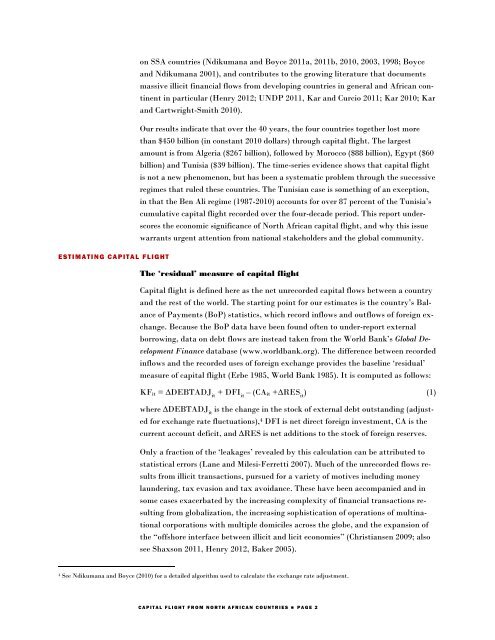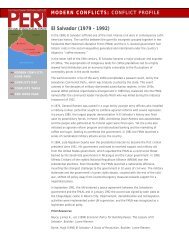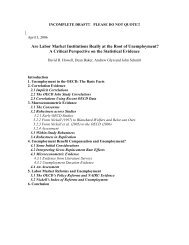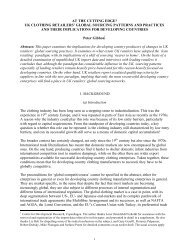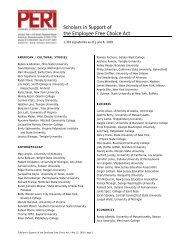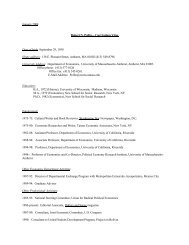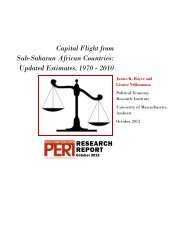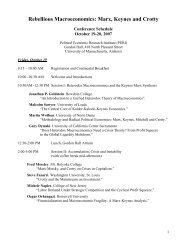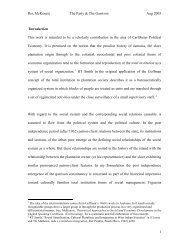Capital Flight from North African Countries - Political Economy ...
Capital Flight from North African Countries - Political Economy ...
Capital Flight from North African Countries - Political Economy ...
You also want an ePaper? Increase the reach of your titles
YUMPU automatically turns print PDFs into web optimized ePapers that Google loves.
ESTIMATING CAPITAL FLIGHT<br />
on SSA countries (Ndikumana and Boyce 2011a, 2011b, 2010, 2003, 1998; Boyce<br />
and Ndikumana 2001), and contributes to the growing literature that documents<br />
massive illicit financial flows <strong>from</strong> developing countries in general and <strong>African</strong> continent<br />
in particular (Henry 2012; UNDP 2011, Kar and Curcio 2011; Kar 2010; Kar<br />
and Cartwright-Smith 2010).<br />
Our results indicate that over the 40 years, the four countries together lost more<br />
than $450 billion (in constant 2010 dollars) through capital flight. The largest<br />
amount is <strong>from</strong> Algeria ($267 billion), followed by Morocco ($88 billion), Egypt ($60<br />
billion) and Tunisia ($39 billion). The time-series evidence shows that capital flight<br />
is not a new phenomenon, but has been a systematic problem through the successive<br />
regimes that ruled these countries. The Tunisian case is something of an exception,<br />
in that the Ben Ali regime (1987-2010) accounts for over 87 percent of the Tunisia’s<br />
cumulative capital flight recorded over the four-decade period. This report underscores<br />
the economic significance of <strong>North</strong> <strong>African</strong> capital flight, and why this issue<br />
warrants urgent attention <strong>from</strong> national stakeholders and the global community.<br />
The ‘residual’ measure of capital flight<br />
<strong>Capital</strong> flight is defined here as the net unrecorded capital flows between a country<br />
and the rest of the world. The starting point for our estimates is the country’s Balance<br />
of Payments (BoP) statistics, which record inflows and outflows of foreign exchange.<br />
Because the BoP data have been found often to under-report external<br />
borrowing, data on debt flows are instead taken <strong>from</strong> the World Bank’s Global Development<br />
Finance database (www.worldbank.org). The difference between recorded<br />
inflows and the recorded uses of foreign exchange provides the baseline ‘residual’<br />
measure of capital flight (Erbe 1985, World Bank 1985). It is computed as follows:<br />
KF it = ∆DEBTADJ it<br />
+ DFI it<br />
– (CA it +∆RES it<br />
) (1)<br />
where ∆DEBTADJ it<br />
is the change in the stock of external debt outstanding (adjusted<br />
for exchange rate fluctuations), 4 DFI is net direct foreign investment, CA is the<br />
current account deficit, and ∆RES is net additions to the stock of foreign reserves.<br />
Only a fraction of the ‘leakages’ revealed by this calculation can be attributed to<br />
statistical errors (Lane and Milesi-Ferretti 2007). Much of the unrecorded flows results<br />
<strong>from</strong> illicit transactions, pursued for a variety of motives including money<br />
laundering, tax evasion and tax avoidance. These have been accompanied and in<br />
some cases exacerbated by the increasing complexity of financial transactions resulting<br />
<strong>from</strong> globalization, the increasing sophistication of operations of multinational<br />
corporations with multiple domiciles across the globe, and the expansion of<br />
the “offshore interface between illicit and licit economies” (Christiansen 2009; also<br />
see Shaxson 2011, Henry 2012, Baker 2005).<br />
4 See Ndikumana and Boyce (2010) for a detailed algorithm used to calculate the exchange rate adjustment.<br />
CAPITAL FLIGHT FROM NORTH AFRICAN COUNTRIES • PAGE 2


